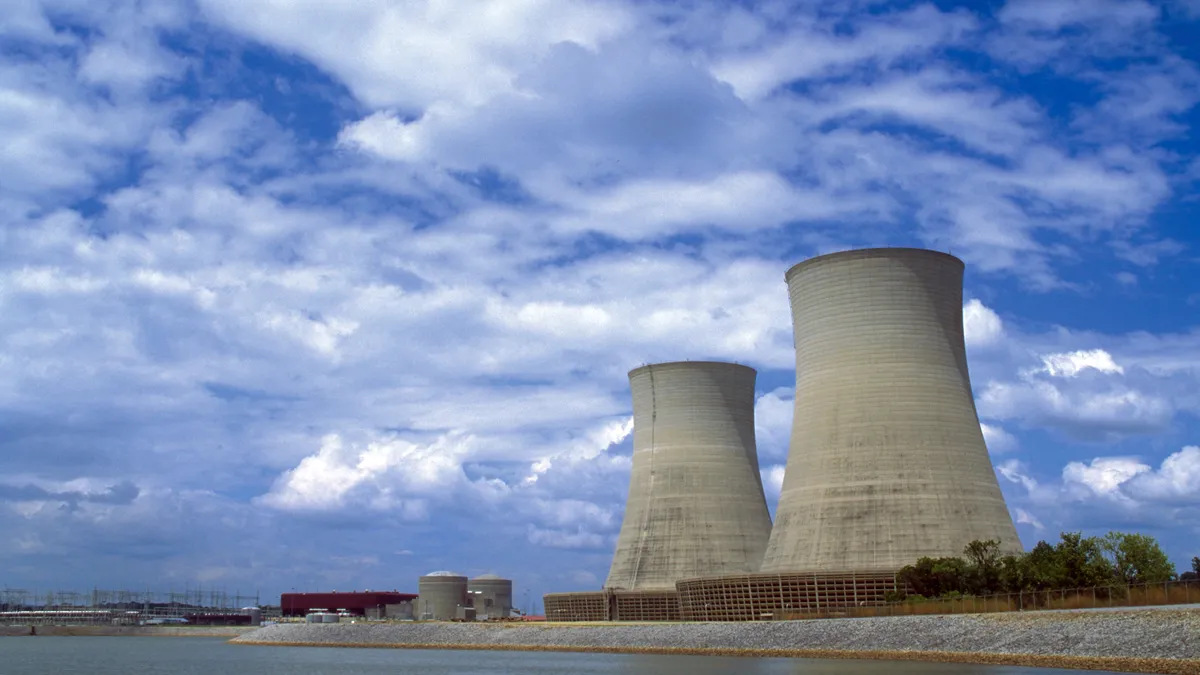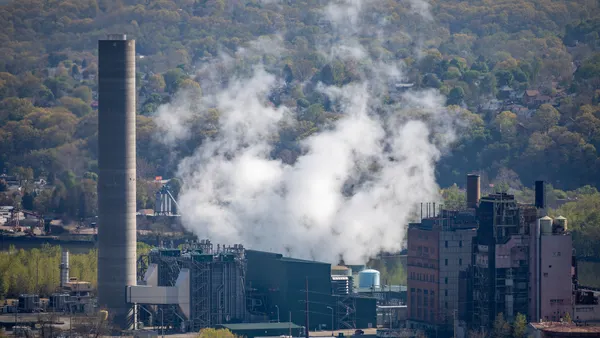Has the market done for the utility power mix what Congress, the Obama administration, and the Supreme Court couldn’t?
Despite the recent legal roadblock from the nation’s top court to the Obama administration plan to regulate climate change-inducing pollution, executives from one end of the utility industry to the other say they don’t see their plans changing much.
In fact, a new survey of more than 500 utility executives conducted by Utility Dive showed that a large majority support the EPA's Clean Power Plan, which aims to cut U.S. carbon emissions 32% by 2030, and a significant portion want to see it strengthened.
Add that to a recent report from the Rhodium Group showing that the extension of key tax credits for renewable energy in 2015 will fuel strong growth for wind and solar despite the plan's judicial difficulties, and it appears the U.S. power mix will continue getting cleaner, whether or not the regulatory package survives its court battles. But while the general trajectory of the power sector appears set, analysts say the Clean Power Plan saga will still have a significant impact on how the transition unfolds.
A brief history of the Clean Power Plan
President Obama has long been dedicated to cutting U.S. emissions by driving a transition to cleaner utility power mix with more emphasis on renewables, natural gas and other low-carbon tehnologies.
His administration spent its first two years trying to pass an energy bill with a cap and trade plan. Behind that effort was the implicit threat that his Environmental Protection Agency (EPA) would use the 2007 U.S. Supreme Court ruling granting EPA’s right to regulate greenhouse gas emissions (GHGs) under the Clean Air Act if Congress didn’t move.
But the energy bill was blocked in Congress, so the EPA acted, issuing the draft proposal for the Clean Power Plan (CPP) in June 2014. After it was finalized in August of 2015, state regulators and utilities across the nation began outlining state plans for compliance, the first of which were due in September of this year.
But CPP opponents sued the EPA, claiming the plan overstepped limits set by the Clean Air Act. In February, the Supreme Court surprised the power sector by issuing a judicial stay on the plan, ruling that no compliance actions could take place until legal challenges to the plan are exhausted. At a conference soon after, the lawyer for the nation's association of state utility regulators told the audience that they judicial stay would likely set the Clean Power Plan deadlines back by about two years.
Yet utility industry plans have not changed significantly.
“You can’t simply put the genie back in the bottle when it comes to major strategic investments that the captains of industry are making," Edison Electric Institute Environment VP Quin Shea recently was quoted in the Washington Post. This was echoed in statements by the American Public Power Association and the Iowa Association of Electric Cooperatives about the SCOTUS-imposed delay.
Warren Buffett’s PacifiCorp, which serves customers across six states in the Upper Plains and Pacific Northwest, and Xcel Energy, which serves eight Plains and Midwestern states, say they will continue to move away from coal, toward natural gas and renewables, and to cut emissions.
A host of other utilities, including Public Service Enterprise Group, DTE Energy, American Electric Power, Southern California Edison, Ameren, Entergy, Exelon, PNM Resources, and Pacific Gas and Electric, have similar plans, according to E&E News.
A power mix shift
Industry executives have been planning for this power mix shift for some time, according to Utility Dive’s State of the Electric Utility 2016 survey. Collectively, 72% see natural gas moderately or significantly increasing in their power mixes over the next 20 years, 77% see wind doing so, and 91% see utility-scale solar doing so.
At the other end of the spectrum, 82% see coal staying the same or moderately or significantly decreasing in their power mixes over the next 20 years, 90% see that happening with nuclear power, and 98% see that happening with oil. Those findings fall in line with the results of the 2015 survey, which revealed similar sentiments toward the power mix.
But those opinions were registered before SCOTUS imposed the CPP delay. If the CPP was designed to drive a power mix that would cut GHGs and it has been delayed, why have utilities have not changed their expectations?
John Larsen, director at the research firm Rhodium Group, says there are three main factors.
First, the U.S. Energy Information Administration (EIA) continues to project very low natural gas prices through the early 2020s, thanks to supplies being slowly drained from the nation’s shale reserves.
Second, Congress provided five year extensions and phase outs for both wind’s $0.023/kWh production tax credit (PTC) and solar’s 30% investment tax credit (ITC).
Third, the price for renewables is dropping steadily. The installed cost for utility-scale wind has dropped 66% since 2009, according to the American Wind Energy Association. And the installed cost for utility-scale solar has dropped over 50% since 2007, according to Lawrence Berkeley National Laboratory.
The National Renewable Energy Laboratory (NREL) projects the installed cost for solar to drop 43% and the installed cost for wind to drop 24% by 2020, according to Larsen.
Those factors explain why it is likely there will be even more renewable generation and/or natural gas in the U.S. resource mix by the 2020s than had previously been predicted, even if the CPP is not just delayed but rejected, according to the Rhodium Group’s just-released report, "What Happens to Renewable Energy Without the Clean Power Plan?"
Low natural gas prices have driven a shift away from coal that was not supposed to happen before 2025 and installed costs for renewables are unprecedentedly low, Federal Energy Regulatory Commission Chair Norman Bay recently told a NARUC audience. As a result, the move to natural gas and more affordable renewables is “not going away, in spite of the current stay.”
With and without the CPP
Based on natural gas prices and installed cost projections for wind and solar from the EIA, the tax credit extensions give renewables “a big boost under the CPP,” Rhodium reports. Without the extensions, the “the least-cost CPP compliance pathway is a shift in power generation from coal to natural gas combined cycle (NGCC).”
With the extensions, however, wind and utility-scale solar become the least-cost compliance pathway and, in 2022, provide some 300 TWh more to the U.S. power mix than previously projected by the EIA.
“It is not a low number, but it is not as big as with the CPP,” Larsen said.
If the Clean Power Plan is thrown out, the ITC and PTC extensions provide only about half that boost in generation capacity, Rhodium’s research note projects.
“Without the carbon constraint of the CPP to shift dispatch, renewables largely displace NGCC generation rather than coal,” the note explains.
With the CPP but not the extensions, the U.S. would add 60 GW of new wind and solar to its power mix from 2016 to 2025, Rhodium forecasts. With the extensions but not the CPP, cost-competitiveness alone will grow 92 GW of new wind and solar. With the CPP, that would become 142 GW.
All told, that means that a decision to throw out the Clean Power Plan could cost the reneawble energy sector and U.S. economy 50 GW of new capacity that Rhodium expects would be added if the plan was upheld.
Forecasting uncertainty
Much of the accuracy of these forecasts will depend on the price of natural gas and renewable energy techologies. While the preceding forecasts were based on EIA numbers, Rhodium also modeled other estimates.
If wind and solar installed costs fall at the rate projected by the NREL Annual Technology Baseline (ATB) and/or natural gas prices remain at their current low level longer than EIA projected, “the outcome could be considerably different,” Rhodium reports.
NREL’s lower installed cost projections for renewables would result in a 250% increase renewable generation by 2022, Rhodium reports. “Cumulative renewable capacity additions between 2016 and 2025 are nearly three times higher.”
In addition, Rhodium expects the natural gas price to be significantly lower going forward than projected by EIA. “Henry Hub gas prices in 2015 were 30% lower than EIA projected at the start of the year and a similar differential is expected for at least the next two years,” Rhodium says.
Taking into account lower-priced natural gas and renewables and the tax extenders, but excluding the CPP, “both NGCC and wind and solar generation get a boost,” Rhodium expects. New wind and solar generation is 2.5 times higher by 2022 than with the EIA numbers.
Renewables would grow to 163 GW, almost twice Rhodium’s reference case and about what they would be with the tax extensions and the CPP, the report concludes. “The biggest loser in this low gas and renewable price environment is coal, with generation nearly 400 TWh below current levels by 2022, even without the influence of the CPP.”
“Economic forces make it a one-two punch against coal,” Larsen said. "First, it is low natural gas prices over the long term. That puts big downward pressure on coal. Low cost, tax credit-supported renewables is the second punch.”
Renewables push coal out of the market until the tax credits phase down in the early 2020s, he added. In the absence of the CPP, renewables growth would then flatten and surviving coal plants would run a little more to meet rising electricity demand.
The wild cards
There are two wild cards in the Rhodium forecast, Larsen said. The first is the at least 15 states that have announced they will continue working on CPP compliance. Those efforts will impact renewables growth and could add to the impact of the tax credit extensions.
The biggest wild card, however, is battery energy storage, Larsen said. The increasing penetration of variable renewables will increase the need for fast-ramping natural gas generation to balance it. “But that comes with costs and technical requirements,” he said
The very different profile of battery energy storage makes it potentially transformational but its cost and performance capabilities remain “anyone’s guess,” Larsen said. “Storage coupled with renewables at the utility scale is essentially a dispatchable base load generation solution. All of a sudden capacity factor is not a factor anymore.”




















